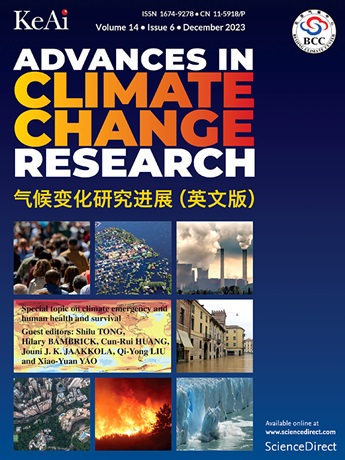2014 - 2022年泛南极冰盖上冰上湖泊的演变:评价与控制因素
IF 5.2
1区 地球科学
Q1 ENVIRONMENTAL SCIENCES
引用次数: 0
摘要
南极表面广泛存在的冰上湖(SGLs)可以加速陆地冰的流动,并与冰架解体有关,从而进一步影响海平面上升的预测。然而,以往的研究大多集中在区域尺度或典型冰架上,低估了SGLs的分布和面积。因此,目前南极洲范围内的SGL分布和变率信息仍然有限,其现状及其对冰架稳定性的可能影响也在很大程度上是未知的。在这里,我们使用了11万多张Landsat 8图像,通过构建良好的基于阈值的方法,在2014年至2022年的南部夏季探测南极洲(83°S以北)的SGLs。总体而言,大多数SGLs位于冰架上,占总面积的79%;东南极洲(79%,2222 km2)最大,远远超过南极半岛(20%,473 km2)和西南极洲(1%,23 km2)。南极半岛和西南极洲的SGL面积分别增加和减少,而东南极洲由于存在一些具有非同步变化模式的冰架而经历了相对较高的年际变化。较小的冰架崩塌风险较大;东南极洲冰架相对不稳定,南极半岛部分冰架的崩解风险正在增大。冰川学因素与SGLs的位置密切相关,温度、降水和风与SGLs的演变密切相关。本研究有望通过提供更全面的数据集来提高现有南极SGL数据集的可靠性,并为SGLs与气候因子和近地表条件之间的关系提供详细的见解。此外,它还研究了由SGLs引起的冰架崩塌的风险,这对于理解SGLs动力学及其影响至关重要。本文章由计算机程序翻译,如有差异,请以英文原文为准。
Evolution of supraglacial lakes over the pan-Antarctic ice sheet between 2014 and 2022: Assessment and the control factors
Widespread supraglacial lakes (SGLs) across the Antarctic surface can accelerate land ice flow and be linked to ice shelf disintegration, further affecting sea-level rise projections. However, previous studies usually focused on SGLs at regional scale or some typical ice shelves, and underestimated the distribution and area of SGLs. Thus, the current Antarctic-wide SGL distribution and variability information is still limited, and the present status and possible influence on ice shelf stability are also largely unknown. Here, we used more than 110,000 Landsat 8 images to detect SGLs across Antarctica (north of 83°S) in austral summer from 2014 to 2022 by using a well-constructed threshold-based method. Overall, most SGLs were located on ice shelves, covering 79% of the total area; the largest SGL areas were found in East Antarctica (79%, 2222 km2), far exceeding the SGL areas in Antarctic Peninsula (20%, 473 km2) and West Antarctica (1%, 23 km2). SGL area gains and declines were found in the Antarctic Peninsula and West Antarctica, respectively, while East Antarctica experienced relatively high interannual variabilities due to the presence of some ice shelves with asynchronous variation patterns. Larger collapse risks are found for smaller ice shelves; ice shelves in East Antarctica are relatively unstable, and disintegration risk is increasing for some ice shelves in Antarctic Peninsula. Glaciological factors are closely related to the location of SGLs, and temperature, precipitation and winds are strongly linked to SGL evolution. This study is expected to enhance the reliability of existing Antarctic SGL dataset by providing a more comprehensive dataset, and offer detailed insights into the relationship between SGLs, climatic factors, and near-surface conditions. Additionally, it examines the risks of ice shelf collapse caused by SGLs, which is essential for understanding the SGL dynamics and their impacts.
求助全文
通过发布文献求助,成功后即可免费获取论文全文。
去求助
来源期刊

Advances in Climate Change Research
Earth and Planetary Sciences-Atmospheric Science
CiteScore
9.80
自引率
4.10%
发文量
424
审稿时长
107 days
期刊介绍:
Advances in Climate Change Research publishes scientific research and analyses on climate change and the interactions of climate change with society. This journal encompasses basic science and economic, social, and policy research, including studies on mitigation and adaptation to climate change.
Advances in Climate Change Research attempts to promote research in climate change and provide an impetus for the application of research achievements in numerous aspects, such as socioeconomic sustainable development, responses to the adaptation and mitigation of climate change, diplomatic negotiations of climate and environment policies, and the protection and exploitation of natural resources.
 求助内容:
求助内容: 应助结果提醒方式:
应助结果提醒方式:


